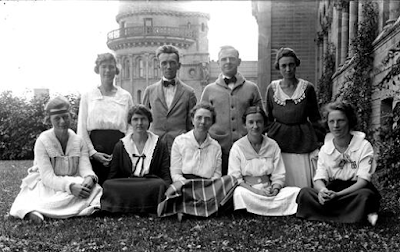 |
| Some of the female employees, graduate students, and volunteer researchers at Yerkes Observatory in the summer of 1916. Names and image credit in the link below. |
In astronomy, there was a strong demand for educated women, who were hired as human computers at facilities such as the Royal Greenwich Observatory in London; the Harvard College Observatory in Cambridge, Massachusetts; and Mount Wilson Observatory near Pasadena, California (5). But their work was routine and required only a basic knowledge of mathematics, not advanced astronomical or astrophysical training. Those observatories hired women because they provided cheap and reliable labor. At Greenwich, for example, calculations had previously been carried out by boys (6). And at Dudley Observatory in Albany, New York, women without college degrees were preferred precisely because they were cheaper (7).
At Yerkes Observatory, however, a different system emerged. Because it was attached to the University of Chicago, which was coed from its foundation in 1890, women astronomers at Yerkes always had the opportunity to obtain advanced degrees. Emily Dobbin became the first woman to earn an MS in astronomy from the university in 1903. Her thesis, “The orbit of the fifth satellite of Jupiter,” was published in the Astronomical Journal the following year (8).
Yerkes was also unique because its location in the southern Wisconsin village of Williams Bay made it accessible. Not only was the municipality the last stop on a train line that connected the town with Chicago, but the observatory’s proximity to the community also enabled women to find respectable accommodations nearby. That was unusual.
Read more at
https://pubs.aip.org/physicstoday/article/76/11/42/2918346/They-were-astronomersUnlike-at-most-other
No comments :
Post a Comment